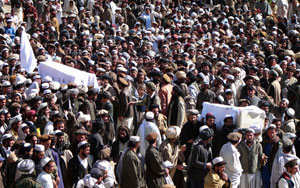(lead article)
Pakistan: 60 killed in 2 U.S. missile attacks
Islamabad cuts deal with Swat Taliban

|
|
AP Photo/Hasbanullah Khan
|
|
People carry coffins at funeral of those killed in February 14 U.S. drone attack in North Waziristan District of western Pakistan, near Afghan border. Funeral took place the following day in Miran Shah, the district’s capital.
|
BY DOUG NELSON
Washington launched what appears to be its most deadly drone missile strikes to date in Pakistan February 14 and 16, killing some 60 people.
The most recent attack was the 86th known missile strike from a drone since the U.S.-led “war on terror” began in 2001. It is the fourth since two simultaneous attacks January 23, which killed about 30 people, including four children, just days after President Barack Obama took office.
Several Predator drones unleashed Hellfire missiles on the home of alleged Afghan Taliban commander Bahram Kochi February 16 in the Kurram Agency of Pakistan’s Federally Administered Tribal Areas (FATA). The strike was the first such attack in Kurram. Previous attacks have focused on the North Waziristan, South Waziristan, and Bajaur agencies.
A February 12 statement by Sen. Dianne Feinstein and a February 18 article in the London Times claimed CIA-operated pilotless drone attacks are launched from Pakistani bases in the country, which the Pakistani and U.S. government deny.
While the Washington Post made a similar claim last year, the recent statements prompted reactions in Pakistan and have complicated Islamabad’s attempt to maintain an official stance in opposition to the unpopular U.S. strikes on its soil.
According to the Post, Pakistani officials have said their intelligence services provide targeting information to the CIA and have requested participation in the decisions in the operations.
“The best way forward is obvious: grant Pakistan some ownership of the drone programme, make sure the public is aware that the ownership is real and meaningful, and widen the list of targets,” said a February 20 opinion piece in Dawn, Pakistan’s most widely circulated English-language newspaper.
Meanwhile, the Pakistani government announced February 21 that it secured a permanent cease-fire with Taliban forces in a region north of the drone attack sites. The agreement cements the Islamists’ influence over the Swat District and surrounding region, covering some one-third of the country’s Northwest Frontier Province (NWFP). While the Taliban leadership based in Swat agreed to a 10-day cease-fire February 15, it has yet to announce a decision for a truce beyond that.
After defeating three Pakistani military offensives since November 2007, Taliban forces led by Mullah Maulana Fazaullah established control of Swat and defacto imposed sharia, or Islamic law, under which they have begun to purge their opposition.
The talks with the Taliban have been brokered through Sufi Mohammad, leader of the Movement for the Implementation of Mohammad’s Sharia Law, who led a failed revolt in 1994 to establish sharia in the region and spent six years in a Pakistani jail after returning from Afghanistan where he led a force of some 10,000 against the U.S.-led troops.
Under the pact, the Taliban are to agree to a cease-fire in exchange for the release of Taliban prisoners, the withdrawal of Pakistani troops, and the establishment of sharia in the NWFP districts of at least Swat, Malakand, Shangla, Buner, and Dir.
Much of the local population has welcomed the prospect of an end to fighting between Taliban and Pakistani forces, according to press accounts. In Swat alone at least 1,200 civilians have been killed by both sides and as many as half a million have been forced to flee their homes as a result of the war.
Some 40 percent of students returned to school in Swat February 23 after all schools had been closed in response to the Taliban bombing and torching of 191 schools, 122 of them for girls. Girls’ public schools have only been open up to the fourth grade.
Meanwhile, three rival Taliban factions based in the Waziristan districts announced the formation in late February of a new Taliban coalition and declared their allegiance to Osama bin Laden and Mullah Mohammad Omar, former head of the Afghan Taliban government. Two of the three factions had opposed fighting the Pakistani government and had come to be referred to as “pro-government Taliban.” The other faction, led by Baitullah Mehsud, is the main Taliban group that has been at war with the government.
“We are attempting to drive a wedge between al-Qaeda and the militant Taliban on the one hand, and Swat’s indigenous movement that seeks to restore traditional law in the district,” said Husain Haqqani, Pakistan’s ambassador to Washington. “This is part of our pragmatic military and political strategy to turn our native populations against the terrorists,” he said.
NWPF chief minister Ameer Haider Kahn Hoti issued orders to distribute 30,000 rifles among “patriotic people” to be used against “miscreants and anti-state elements,” Pakistan’s Daily Times reported February 23.
When asked February 18 how confident he was in the assurances from Islamabad that the deal won’t give the Taliban greater reach, U.S. defense secretary Robert Gates said, “We have some experience with these agreements. Maybe this will buy some breathing space for the Pakistani army, but I would say we’ll wait and see.”
“If insurgents are made to put down their arms, if the reconciliation is essentially on the terms being offered by the government, then I think that we would be very open to that,” Gates said when asked February 20 whether similar deals could be made in Afghanistan.
Related articles:
Imperialist troops out of Pakistan!
| 


